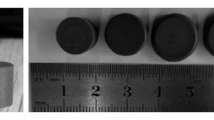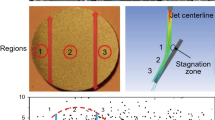This study investigates the characteristics of shaped charge jet formed with a high-polymer (PTFE) liner, as well as its penetration capabilities, by theoretical, experimental, and numerical methods. This work presents a viscoplastic model and equation of compressible fluid to describe the jet cohesive condition. It also shows that the high-polymer jet is inevitably distended. Two types of liner materials were studied: a high-polymer PTFE liner and a pure copper one. The corresponding numerical simulations of the two jet formations are presented. The pulse X-ray photographic technology was employed to observe the distended jet of the PTFE liner and the particulate jet of the copper one. The simulation and jet radiography results show that the two types of jet behavior with particulate and radial dispersion are ductile and related to the liner material. The distended jet formation result from the liner material was crushed at the high-pressure region because a sudden pressure jump induces the radial velocity rise, which results in lateral expansion. As compared with a typical copper penetration performance, the polymer distended jet had a larger aperture and lower penetration depth. Due to polymer liner lower density, this jet will have limited penetration as compared to that of a copper liner. The simulated results strongly agree with the experimental ones. The polymer material can be modified to obtain much better performance, which will greatly enhance the penetration capacity of polymer jets.








Similar content being viewed by others
References
C. Wang, J. X. Ding, and H. T. Zhao, “Numerical simulation on jet formation of shaped charge with different liner materials,” Defence Sci. J., 65, No. 4, 279–286 (2015).
B. Zygmunt and Z. Wilk, “Formation of jets by shaped charges with metal powder liners,” Propell. Explos. Pyrot., 33, No. 6, 482–487 (2008).
K. G. Cowan and B. Bourne, “Oxide glasses as shaped charge liners,” in: Proc. of the 21th Int. Symp. on Ballistics, Adelaide, South Australia (2004), pp. 419–423.
L. J. Keeskes and W. P. Walters, “Investigation of a bulk metallic glass as a shaped charge liner material,” in: Proc. of the 23th Int. Symp. on Ballistics, Tarragona, Spain (2007), pp 31–38.
E. L. Baker, S. DeFisher, A. Daniels, et al., “Glass as a shaped charge liner material,” in: Proc of the 26th Int. Symp. on Ballistics, Miami, FL (2007), pp. 340–347.
A. Helte and J. Lundgren, “Non-initiating precursor charge technology against era,” in: Proc. of the 26th Int. Symp. on Ballistics, Miami, FL (2007), pp. 313–318.
E. Hirsch and L. Sadwin, “SDSC – a structure destroying shaped charge,” in: Proc. of the 24th Int. Symp. on Ballistics, New Orleans, LA (2008), pp. 1110–1113.
J. Haney and D. Wesson, Shaped-Charge, US Patent US20050056459 A1 (2005).
B. H. Chang, J. P. Yin, Z. Q. Cui, and T. X. Liu, “Numerical simulation of modified low-density jet penetrating shell charge,” Int. J. Simul. Model., 14, No. 3, 426–437 (2015).
B. H. Chang, J. P. Yin, Z. Q. Cui, and T. X. Liu, “Improved dynamic mechanical properties of modified PTFE jet penetrating charge with shell,” Strength Mater., 48, No. 1, 82–89 (2016).
A. Chulya and K. P. Walker, “A new uniformly valid asymptotic integration algorithm for elasto-plastic-creep and unified viscoplastic theories including continuum damage,” Int. J. Numer. Meth. Eng., 32, No. 2, 85–418 (1991).
S. K. Godunov, A. A. Deribas, and V. I. Mali, “Influence of material viscosity on the jet formation process during collisions of metal plates,” Combust. Explo. Shock+, 11, No. 1, 1–13 (1975).
Acknowledgments
The authors would like to acknowledge the financial support from the Project supported by the National Natural Science Foundation of China under Grant No. 11572291.
Author information
Authors and Affiliations
Corresponding author
Additional information
Translated from Problemy Prochnosti, No. 1, pp. 34 – 44, January – February, 2017.
Rights and permissions
About this article
Cite this article
Yi, J.Y., Wang, Z.J., Yin, J.P. et al. Numerical Simulation of Steel Target Penetration by Shaped Charge Distended Jet with a High-Polymer Liner. Strength Mater 49, 27–36 (2017). https://doi.org/10.1007/s11223-017-9838-8
Received:
Published:
Issue Date:
DOI: https://doi.org/10.1007/s11223-017-9838-8




